[FIX] Error 0XC00D3E8E on Windows 10 (The Property is Read-Only)
Some Windows 10 users are encountering the 0XC00D3E8E error (The Property is read-only) when attempting to modify, delete or rename a specific video file that’s currently stored in their local library. Most commonly, the error code is known to pop up when the user attempts to save or confirm the changes that they recently made.
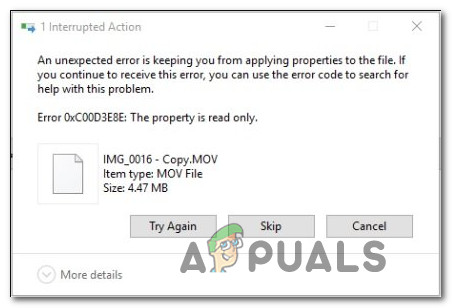
After investigating this particular error code, it turns out that there are several different underlying culprits that might be responsible for this error code. Here’s a list of potential scenarios that might be causing The Property is read-only on your Windows 10 computer:
- The Video file is locked – As it turns out, this particular issue is often reported to occur due to an ownership issue that is preventing the user from modifying, moving, or deleting the video file. In this case, you can resolve the issue by unlocking the file with an automated tool like Unlocker.
- Video file contains tag restrictions – If you are encountering this issue with a lot of different videos currently residing on your computer, you might be able to fix the issue by using the Foobar utility to strip files (in bulk) from the tags that might be causing the issue.
- Problematic video metadata – It’s also possible to see this type of error due to some type of problematic metadata that was most likely migrated from an older OS. Some users facing the same issue have confirmed that the issue was resolved after they used FFMPEG to strip the video objects from their metadata.
- Read-Only field of Movie Media – Under certain circumstances (if you are seeing this issue while trying to move or modify a movie media, chances are the issue is DRM related. In this case, you can fix the problem by using the ExifTool to resolve the read-only field.
- System file corruption – Depending on the specific of your PC, it’s also possible to deal with this error due to some type of system file corruption that is affecting your computer’s ability to deal migrate video files. Other users facing the same issue have managed to fix the issue by running DISM and SFC scans or performing a repair install procedure.
- OS is NOT unsuitable for dealing with .MOV files – As it turns out, Windows 10 needs a particular feature update in order to be able to understand and facilitate the video playback of .MOV files natively. If this is why the error is occurring, you can fix the issue by forcing the installation of every pending update.
Now that you are familiar with every potential culprit that might be responsible for this issue, here’s a list of potential fixes that other affected users have successfully used to get to the bottom of this issue:
Method 1: Unlocking the Video File
According to some affected users, one of the most common instances that will cause the 0XC00D3E8E error code is some kind of ownership issue that is preventing you from modifying, moving, or deleting the video file that’s triggering the ‘Property is read-only’ error message.
If this scenario is applicable, you should be able to take ownership of the file with freeware like Unlocker and manage them as you see fit without encountering the same kind of error.
If you’re looking for step by step instructions on how to do this, follow the instructions below:
- Open any browser on your PC and visit the Softpedia download page of Unlocker. Inside the correct page, click on the Download Now button, pick a mirror and wait for the process to complete.
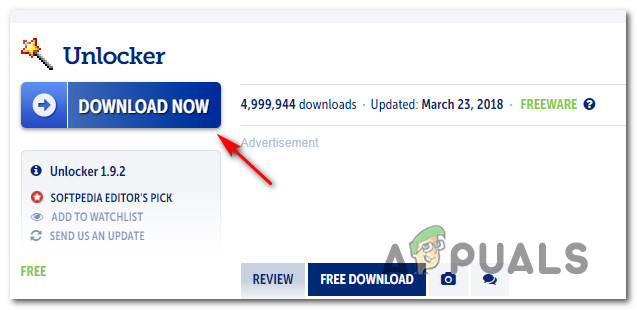
Downloading Unlocker - After the download is complete, double-click on the installer, then click Yes at the UAC (User Account Control).
- Next, follow the prompts to complete the installation of Unlocker, then restart your computer at the end of this process.
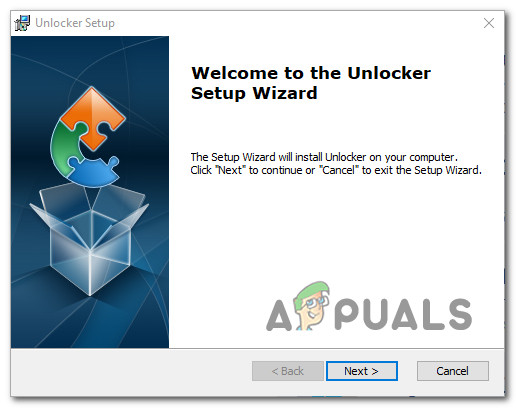
Downloading the Unlocker freeware - Once Unlocker is successfully installed, open it, then use the Browser window to navigate to the location of the file/folder, then click it once to select it before clicking Ok.
- At the next prompt, use the No Action drop drown menu to select Delete, Rename or Move the file, then go ahead and click Ok to successfully manage the locked object.
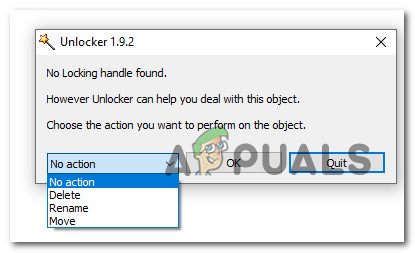
Deleting the locked folder
In case you’re still encountering the same 0XC00D3E8E error even after you’ve used the Unlocker tool to give yourself full ownership of the file, move down to the next potential fix below.
Method 2: Using Foobar to Strip the File from any Tags
Some affected users have reported that have found a workaround that’s ideal for big batch jobs that will take a lot of time if handled individually. Since this particular error is almost always caused by improper info and tags that is prohibiting your OS from making any changes to the file.
If you’re encountering the 0XC00D3E8E error when attempting to modify, move or delete a lot of different video files, you should consider using a utility like Foobar2000 to strip them from any tags that might be triggering this particular error code.
Follow the instructions below to use the Foobar2000 app to select every affected file all at once and strip them from any problematic tags that might be causing this error code:
- Open your default browser and navigate to the download page of the Foobar2000 application.
- Once you’re inside, download the latest available version by clicking on the hyperlink associated with the latest stable version.
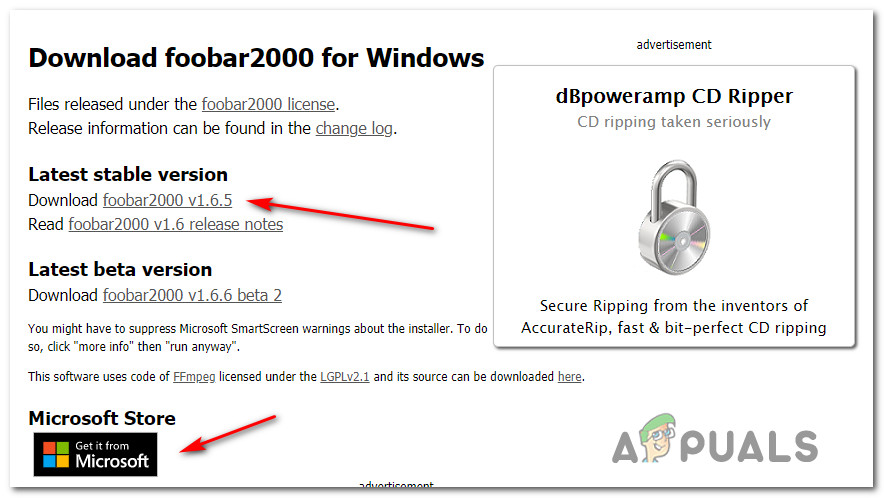
Downloading the latest version of Foobar app Note: You can also download the UWP (Universal Windows Platform) if you are using Windows 10.
- After the initial download is complete, double-click on the installer that you’ve just downloaded, then click Yes at the UAC (User Account Control) to open the Foobar2000 app with admin access.
- Next, follow the on-screen prompts to complete the installation of the Foobar2000 app.
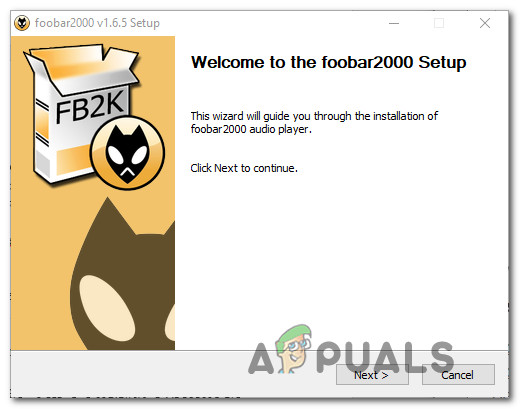
Opening the Foobar2000 app - At the EULA prompt, click Yes to grant admin access, then follow the remaining installation instructions to complete the operation before restarting your computer.
- After your computer boots back up, use the ribbon bar at the top to select File, then click on either Add Folder or Add File to load the problematic video/s into the app (depending on if you’re encountering this issue with one file only or every video file present in a folder).
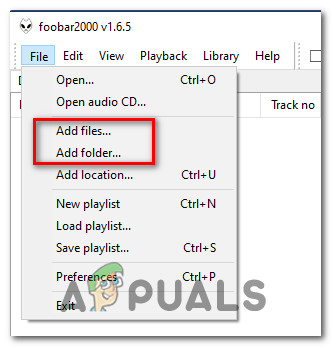
Adding the Files & Folders - Next, once the file/s have been able into the Foobar2000 app, right-click on the video (or select everything) and choose Properties from the context menu that just appeared.
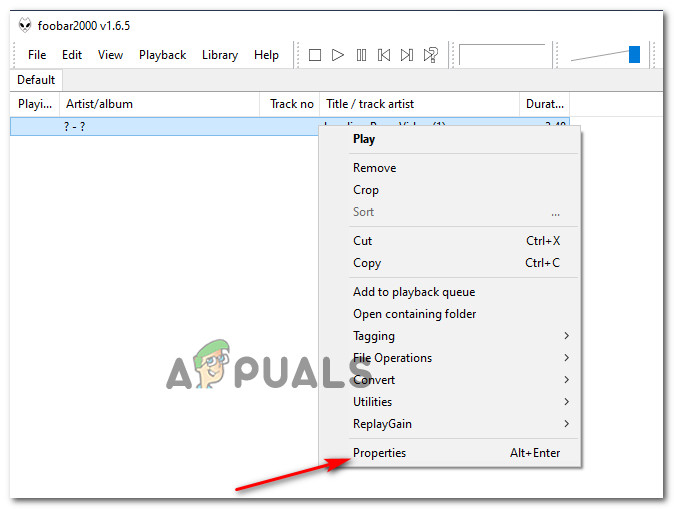
Accessing the Properties screen - Inside the Properties screen, click on the Tools button, then select Remove tags from the menu that just appeared.
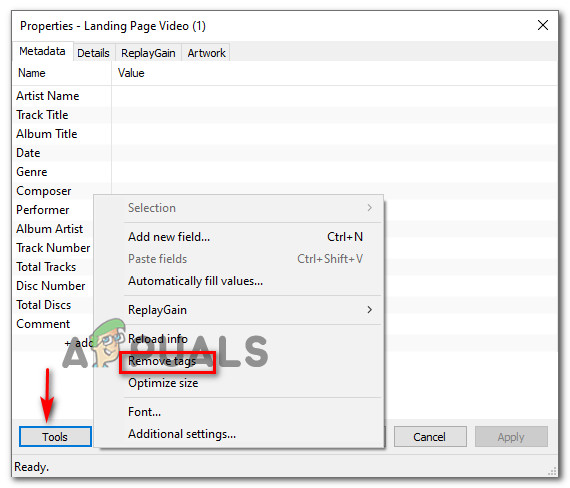
Removing the problematic video tags - Once the tags have been successfully removed, close the Foobar2000 app and then repeat the action that was previously triggering the 0XC00D3E8E error code.
In case the same kind of issue is still occurring, move down to the next potential fix below.
Method 3: Using FFMPEG to Strip Object Metadata
If the solution above (utilizing Foobar2000) was not effective in your case, there’s also the option to strip the video file from any metadata that might cause this issue by using FFMPEG.
However, keep in mind that this method is a little technical and will require you to do some browsing via an elevated CMD terminal.
But if you are up for the task, the instructions below should allow you to strip the video object from any metadata that might be responsible for the 0xc00d3e8e error code.
Here’s what you need to do:
- Open your default browser and navigate to the download page of FFMPEG.
- Once you’re on the correct page, click on the Download button and wait until the operation is complete.
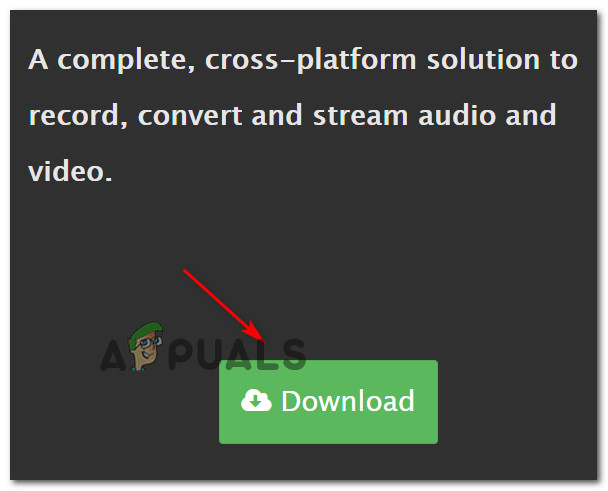
Downloading the FFMPEG utility - After the download is complete, extract the contents of the archive into your preferred location.
- Once the FFMPEG utility is on your computer, go ahead and copy the videos that you want to strip from metadata into the same folder where you installed the FFMPEG utility.
- Next, press Windows key + R to open up a Run dialog box. Inside the run box, type ‘cmd’ and press Ctrl + Shift + Enter to open up an elevated Command Prompt. If you are prompted by the UAC (User Account Control), click Yes to grant admin access.
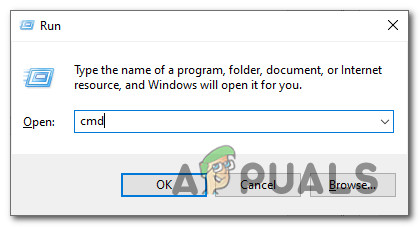
Opening the CMD prompt - Inside the elevated CMD prompt, navigate to the location of the folder where you previously installed the FFMPEG utility by using the CD command like the following example:
CD [/D] [drive:][path]
Note: [/D] [drive:] and [path] are simply placeholders that you need to replace with the actual locations and letters in your particular situation.
- Type the following command and press Enter to strip the video object from any metadata that might be causing this error code:
ffmpeg -y -i "NAME.FORMAT" -c copy -map_metadata -1 -metadata title="NAME OF VIDEO" -metadata creation_time=2021-09-20T21:30:00 -map_chapters -1 "test.FORMAT"
Note: NAME, FORMAT, and NAME OF VIDEO are all placeholders that you need to replace with the names specific to your particular scenario.
- After the command above has successfully stripped the video from any metadata that might be causing this issue, move down to the next potential fix below.
Method 4: Resolving the Read-Only field of Movie Media (via ExifTool)
As it turns out, some users that were also dealing with the same 0XC00D3E8E error code have reportedly been able to fix the read-only field of movie media after using the ExifTool tool.
This free tool will allow you to copy the file into the same folder and get rid of the read-only information that is causing your PC to display the ‘The Property is read-only’.
If you’re looking for instructions on how to use ExifTool, follow the steps outlined below:
- Press Windows key + R to open up a Run dialog box. Next, type ‘cmd’ inside the text box and press Ctrl + Shift + Enter to open up an elevated Command Prompt window. If you are prompted by the UAC (User Account Control) window, click Yes to grant admin access.
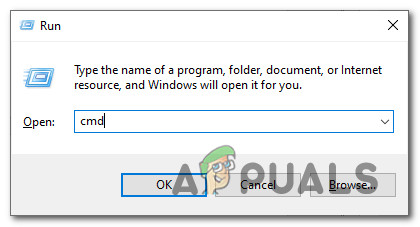
Accessing the CMD prompt - Inside the elevated command prompt, use the CD command to navigate to the folder where the video is currently residing. Consider the following example:
CD [/D] [drive:][path]
Note: [/D] [drive:] and [path] are simply placeholders that you need to replace with the actual locations and letters in your particular situation.
- Next, type the following commands in order and press Enter after each one to strip the video from the read-only field of movie data:
exiftool YOURFILE.MP4 exiftool -CreateDate=YYYY:MM:DDHH:MM:SS YOURFILE.MP4
Note: Make sure to replace YourFile with the actual name of your file.
- Once the video file has been stripped of the read-only field of movie media data that might be causing the error, try to move, delete or modify it again and see if the same error is still occurring.
If the same ‘The Property is read-only’ error popup I still popping up, move down to the next potential fix below.
Method 5: Deploying SFC and DISM Scans
As it turns out, one of the most common instances that will trigger ‘The Property is read-only’ error when trying to modify certain video formats, chances are you’re dealing with a system file corruption that is affecting the auto-updating function of Windows installation.
Several affected users that were dealing with the same kind of issue have reported that they were finally able to modify or delete the video file after running a couple of scans with two built-in utilities – System File Checker (SFC) and Deployment Image Servicing and Management(DISM).
Both SFC and DISM share some similarities, our recommendation is to run both scans in quick succession in order to improve your chance of fixing the corrupted system files.
In this case, deploy a simple SFC scan.
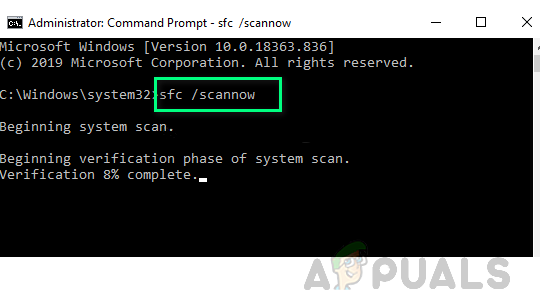
Note: This tool is entirely local and will not require you to be actively connected to the internet.
Important: As soon as you initiate this procedure, it’s very important to not close the CMD window even if the utility looks like it froze. Wait until the process is complete because if you end up interrupting the operation you might cause logical errors on your HDD/SSD.
As the SFC scan is wrapped up, reboot your computer and see if the issue is fixed once the next computer startup is complete.
If the same 0XC00D3E8E error is still occurring when you attempt to modify, move or delete video files, deploy a DISM scan and follow the on-screen prompts to complete the operation.
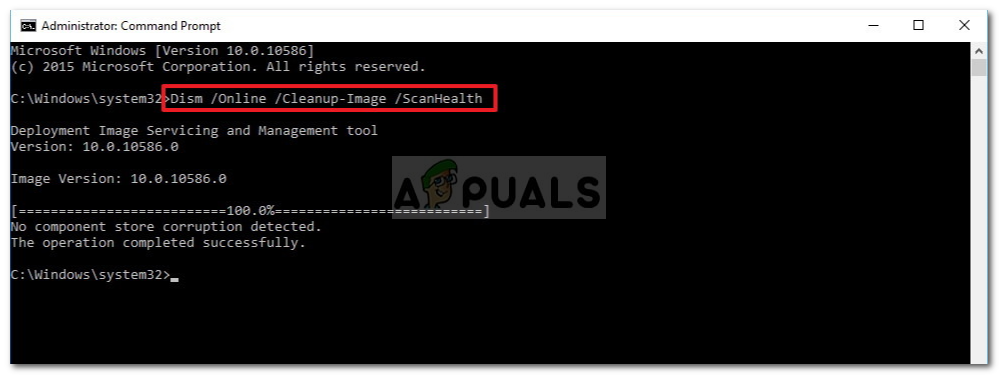
Note: DISM uses a sub-component of Windows Update to download healthy equivalents to replace corrupted system files. Keep this in mind and make sure that you have reliable Internet before initiating this operation.
After the DISM scan has been completed successfully, restart your computer once again and see if the 0XC00D3E8E error is now fixed.
If the 0XC00D3E8E error (The Property is read-only) is still not fixed, move down to the next potential fix below.
Method 6: Install every Pending Windows Updates
As it turns out, this issue can also occur due to a missing video playback infrastructure that’s missing from your Windows 10 installation. This is typically reported to occur with .MOV and other newer video file formats.
If you suspect this scenario might be applicable, you should be able to fix the problem by installing every pending WIndows update following the official channels ensuring that you’re running on the latest build of Windows 10.
In case you think this scenario might be applicable, follow the instructions below to open the Windows Update component and use it to install every pending update to bring your Windows to build up to date:
- Open up a Run dialog box by pressing Windows key + R. Next, type “ms-settings:windowsupdate” inside the text box and press Enter to open up the Windows Update tab of the Settings app.
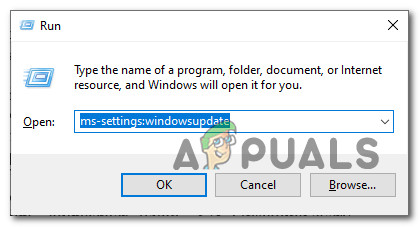
Opening the Windows Update tab - Inside the Windows Update screen, move over to the right-hand pane and click on Check for Updates. Next, follow the on-screen instructions to install every pending update.
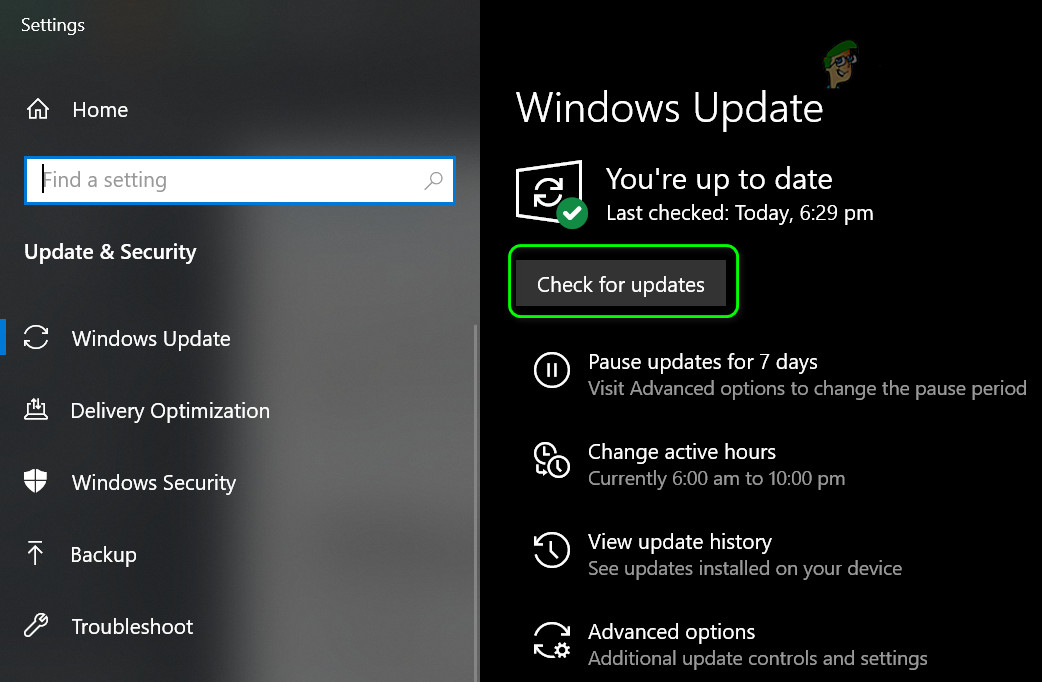
Checking for Windows Updates Note: In case the WU component has a lot of pending updates to handle, it will prompt you to restart before you get the chance to install every pending update. In this case, restart when instructed but make sure to return to the same Windows Update screen at the next startup and complete the download & installation of the remaining updates.
- Once you manage to installed every pending WIndows update, restart your computer then repeat the action that was previously causing the 0XC00D3E8E error (The Property is read-only) issue and see if the problem is now fixed.
If the same kind of problem is still occurring, move down to the next potential fix below.
Method 7: Repair-installing your Windows
In case none of the methods above have proven to be effective in your case, you should consider the fact that the 0XC00D3E8E error might be occurring due to an underlying corruption issue.
If this scenario is applicable, you should be able to resolve the issue by performing a repair install. Some users have confirmed that this method was successful in helping them install every pending update after successfully refreshing every corrupted Windows element.
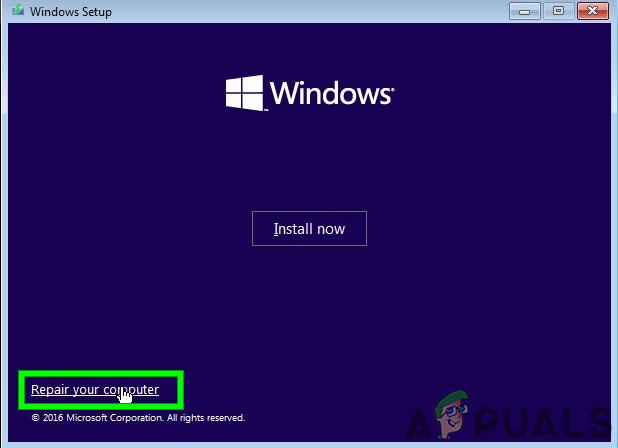
This procedure is superior to a clean install since it will only refresh Windows components and booting-related processes and allow you to keep all personal data including photos, applications, games, videos, and any other type of personal files.
Here are the step-by-step instructions on deploying a repair install procedure.




